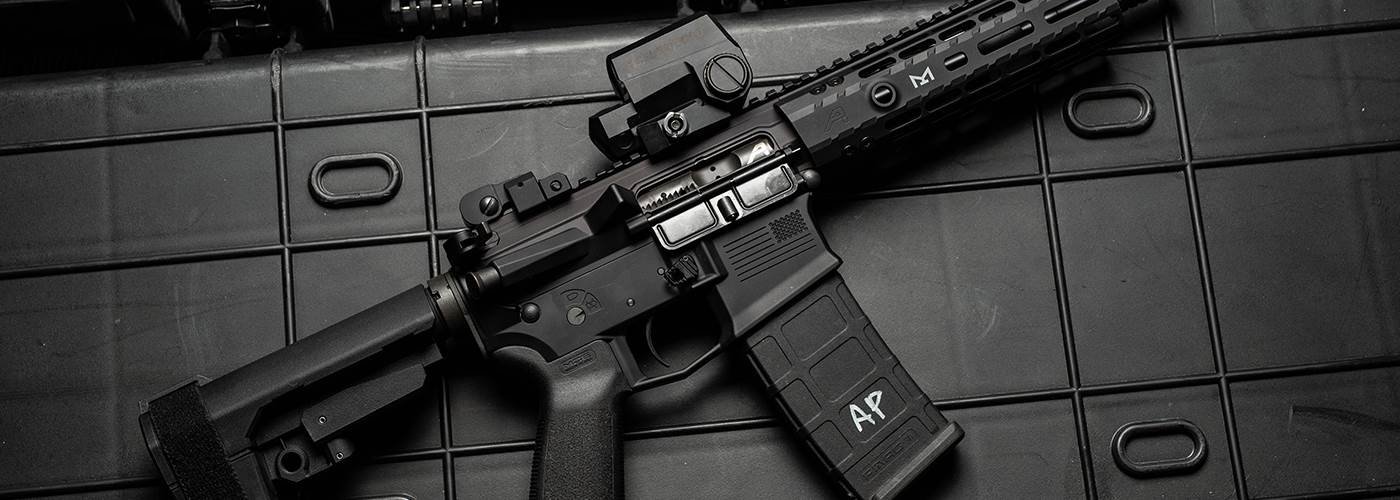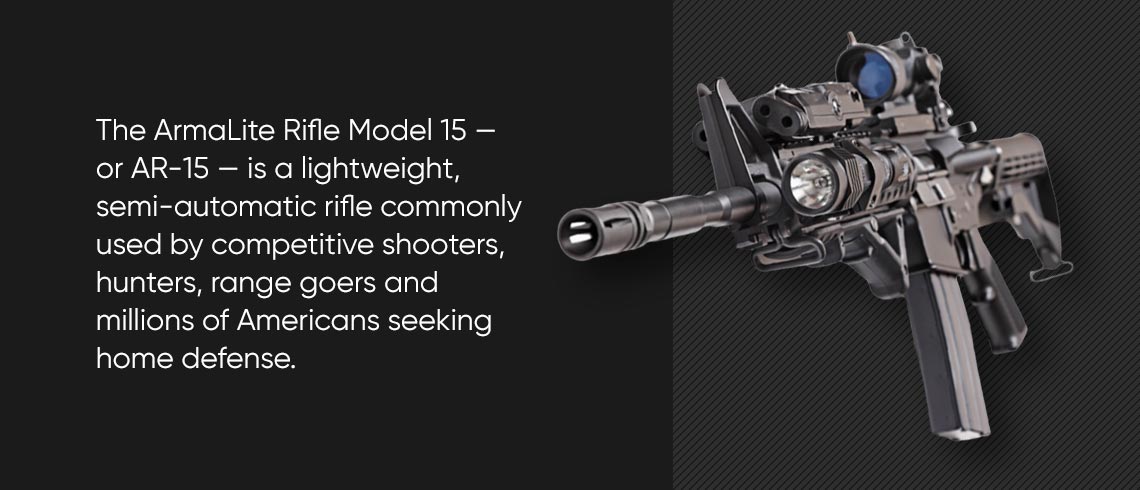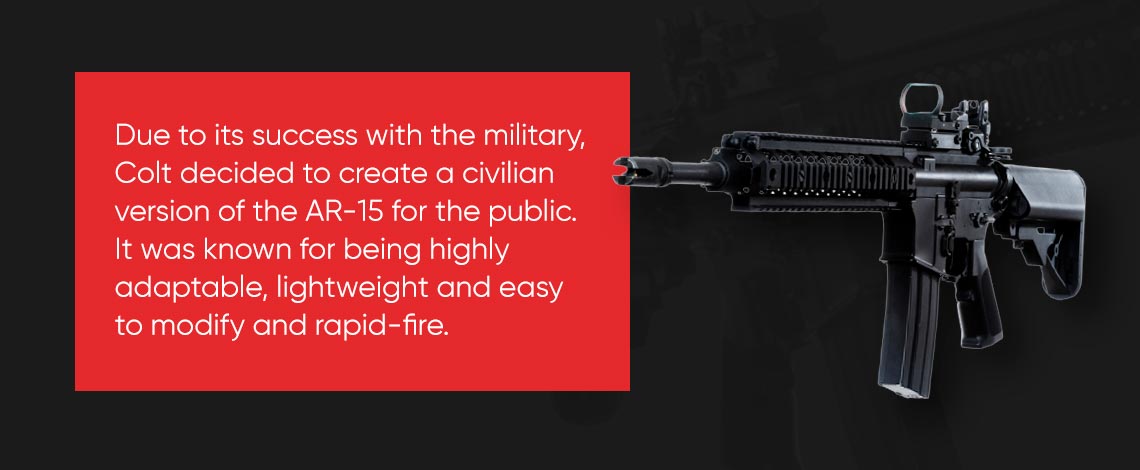
The AR-15 may have gotten off to a rocky start, but with some major and minor tweaks over the years, the same general concept and design remain prevalent in military service and the civilian market alike.
With its high accuracy, versatility, easy handling and lightweight nature, the AR-15 is truly one of a kind. How exactly did this rifle come to be? Discover the unique history of the AR-15, from its initial creation process to upgrades and modifications over time.

What Is an AR-15?
The ArmaLite Rifle Model 15 — or AR-15 — is a lightweight, semi-automatic rifle commonly used by competitive shooters, hunters, range goers and millions of Americans seeking home defense. Gun owners can easily customize it with lasers, scopes, bump stocks and other accessories. Its modular platform can be used for various shooting disciplines and applications.
The AR-15 was developed in the 1950s by the small California company ArmaLite, hence its name. As a modern sporting rifle (MSR) with features like expanded magazine capacities and rapid firing abilities, it's among the most popular firearms on today's market.
While AR-15s are very popular, they're also widely misunderstood. AR-15s closely resemble military rifles, such as the M16, but they don't operate the same way. They function like any other semi-automatic civilian sporting gun, firing only one round with each pull of the trigger.
Contrary to the misinformation surrounding these firearms, AR-15s aren't machine guns or fully automatic rifles. True automatic rifles have been restricted from civilian ownership since the 1930s. MSRs are subject to all federal, state and local regulations, including the 1934 National Firearms Act and the 1968 Gun Control Act. Perhaps no firearm in history has received as much praise, fame and criticism simultaneously as the AR-15.
The Creation of the AR-15
The AR-15 history and development had some interesting twists and turns that would eventually lead to its popularity today. Explore its creation process below.
Development of the AR-5
George Sullivan founded the ArmaLite company in the early 1950s and originally focused on weapon design rather than manufacture and production. Eugene Stoner, the chief architect behind the designs, helped develop the company's first weapon in 1954 — the AR-5. Featuring a .22 Hornet round, this bolt-action rifle was designed as a survival rifle for the United States Air Force.
The flight crew needed a lightweight, compact rifle that was easy to stow away onboard a bomber. This was the concept behind the AR-5, also called the MA-1. The AR-5 was easy to take apart and stash — it could even float, making it useful for water landings.
Development of the AR-10
The U.S. military decided to replace the M1 Garand in 1955. The World War II staple had served the crew well, but it had a limited ammunition capacity of only eight rounds.
Stoner presented his AR-10 model design to the military in 1956 as a potential replacement for the M1. The prototype boasted the following features:
- Elevated sights
- Straight stock
- Recoil compensator
- Aluminum flash suppressor
- Gas system
The AR-10 received mostly high praise from the military — many of the testers believed it to be one of the best rifles they'd ever fired. However, the barrel couldn't pass the "torture test" and burst under pressure. ArmaLite quickly introduced a steel barrel in response to this issue, but it was too late by that point.
The Springfield Armory discouraged the military from adopting the AR-10 rifle, claiming it would require five or more years of testing to get the rifle up to code. They instead picked the T44, now called the M14. The M14 was a larger, fully automatic rifle chambered in .30-06, creating significant recoil.
ArmaLite Sells the AR-15
While the AR-15 originated from the ArmaLite company, it truly gained traction when Colt's Manufacturing Company bought its patent. Colt would go on to produce a military version of the firearm called the M16, which would become the standard weapon of the Vietnam War.
ArmaLite was in deep financial turmoil by 1959 and could no longer manufacture or experiment with the new rifle, so they sold off both the AR-10 and new AR-15 designs to Colt. The AR-7 was also being launched full scale during this time — it was marketed as a civilian survival rifle but saw some military use as well.
Creation of the M16
Stoner decided to leave the ArmaLite company in 1961 and became a consultant at Colt. The Air Force was testing the AR-15 around this time, commissioning over 8,000 for use. They dubbed it the M16, the U.S. military's most famous service weapon. The M16 combined the AR-15's minimal recoil and lower weight with the M14's fully automatic firing capability, making some minor tweaks to the M14's internal components.
After seeing an AR-15 demonstration, General Curtis Lemay was extremely impressed with its performance and placed 80,000 of them on order for the Air Force.
While the new rifle showed great success, the U.S. Army wasn't too keen on adopting it, primarily because America was outmatched by its Russian counterpart, the AK-47, in South Vietnam. And while the M14 was clearly inferior to the M16, the U.S. Army didn't want to replace it.
Despite this pushback, the M14's production problems eventually prompted its replacement. The U.S. needed a rifle that could be used in all four service branches, resulting in the M16 becoming the primary service rifle in 1965.
While it was a step up from the M14, the M16 didn't come without flaws. Colt marketed the rifle as "self-cleaning," and soldiers weren't given cleaning kits. Therefore, the rifles were never clean and would jam constantly. Failure to extract was a common issue, as the cartridge would lodge in the chamber after firing.
This prompted the much-needed design of the M16A1, a modified version of the M16. It included a comic book outlining how to clean and care for the rifle, along with intensive firearm cleaning training programs. It also featured a chrome-plated bore and chamber to prevent stuck cartridges and corrosion. Other modifications like new cleaning kits, lubricants and powder solvents were issued as well.
The M16A1 achieved high favor among American troops in Vietnam as a result of these upgrades. It officially became the U.S. military's standard service rifle in 1969.

AR-15 Production for Civilians
Due to its success with the military, Colt decided to create a civilian version of the AR-15 for the public. It was known for being highly adaptable, lightweight and easy to modify and rapid-fire.
Following in Colt's footsteps, other companies like Smith & Wesson (S&W) and Remington began developing other variations of the AR-15. While these companies gave the rifles their own names, the AR-15's popularity remained and became the go-to nickname for those types of firearms.
Civilian production was halted from 1994 to 2004 when the Federal Assault Weapons ban illegalized them. However, this ban didn't show a significant decrease in gun violence overall.
Development of the M4 Carbine
The M16 has been the U.S. military's service firearm for many years but is gradually being phased out by the M4 Carbine. While its design is based on the M16, the M4 rifle is shorter and lighter. While losing traction in the U.S., the M16 remains a popular rifle for militaries worldwide. Likewise, the AR-15 is a favorite among gun hobbyists and hunters, as well as one of the market's most popular MSR choices.
As you can see, perfecting the AR-15 wasn't an overnight task. It required several years of considerable trial and error to get where it is now. Today, Eugene Stoner is well-known for his cutting-edge designs that led to the AR-15.
AR-15 vs. M16
Many believe the AR-15 and M16 are essentially the same gun, but they have a few important differences.
The AR-15 and M16 have similar origins, appearances and other features in common. Upon comparing them more closely, however, it's easy to see the distinctions between them, both in form and function. Most of these differences relate to the M16's fully automatic capabilities. Here are some key differences between the AR-15 and M16:
- Lower parts kit: The M16 and AR-15 have different lower parts kits, which include components like the trigger, safety selector lever, hammer and disconnector. The main distinction between these parts is that the M16's lower parts kit uses an auto sear. This allows the rifle to fire in full automatic, or fire three-round bursts.
- Bolt: The M16's bolt design varies slightly from the AR-15's bolt carrier group to allow for full-auto function. The M16's bolt carrier features more rear mass. This interacts with the sear, helping decrease felt recoil when the firearm is set to automatic.
- Lower receiver: The AR-15's lower receiver contains different internal dimensions that prevent it from accepting the M16's auto sear.
AR-15 and M16 Similarities
Given the AR-15 and M16 share many of the same roots and appearance, it's no surprise that they also have many similar features, with several of their components being interchangeable. Their upper receivers are essentially identical, bearing resemblances in the following areas:
- Barrel: An AR-15 barrel can be chambered for various calibers, which we'll later discuss in more detail. M16 generally fires 5.56 NATO, and many AR-15s are chambered for .223 and 5.56. This means they can either use the NATO rounds or the .223 Remington, their parent cartridge. However, those specifically chambered for .223 shouldn't be loaded with 5.56, as these rounds create different levels of pressure.
- Gas tube: The gas tube directs hot gas back to the upper receiver. This pushes the bolt backward and extracts an empty casing.
- Gas block: An AR-15 barrel has a small hole in the top that releases gases when you fire a round. The gas block catches these gases, then directs them to cycle the bolt.
- Firing pin: The firing pin pierces the cartridge primer after the hammer is released.
- Charging handle: The charging handle — also known as the bolt handle or cocking handle — pulls the bolt carrier group back to cock the hammer.
The AR-15 and M16 also have identical components in their lower receivers:
- Buffer and buffer tube: The AR-15 platform's buffer system helps reduce recoil, improving the overall design.
- Buttstock: The buttstock, or stock, is located behind the breech of the gun to provide structural support. Many gun owners choose to fit their AR-15s with a classic military-style fixed stock.
- Pistol grip: The pistol grip attaches to the lower receiver, allowing you to hold and fire the rifle comfortably.
- Recoil spring: The recoil spring is located in the buffer tube. It compresses as gas pushes the bolt rearward, pushing the bolt forward again to load a subsequent round when it reaches maximum compression.

AR-15 Modularity and Variations
The AR-15 is one of the most modular firearm platforms you can find. Many options are available at different prices, and it's easy to replace and swap out various parts and pieces. Both civilian and military models feature a special two-part receiver, allowing for simple disassembling and cleaning.
The M16 platform has also seen upgrade and replacement attempts for law enforcement and military purposes. Various calibers, like the 300 Blackout and 6.8mm Special Purpose Cartridge (SPC), have been specially created and tested for this platform.
Speaking of calibers, the AR-15 has a range of chambering methods, another facet of its impressive modularity. Sometimes even a simple swap of the upper receiver transforms the caliber completely. While the classic .223 and 5.56 are most common, AR-15s can also be chambered in the following cartridges, as well as many others on the market today:
- .17 Hornady Magnum Rimfire (HMR)
- .22 Long Rifle (LR)
- .204 Ruger
- .224 Valkyrie
- 243 Winchester
- 9 mm
- .40 S&W
- .45 Automatic Colt Pistol (ACP)
With its many caliber possibilities, it's no wonder the AR-15 has grown incredibly popular among hunters, long-range precision shooters and other gun owners. Its modularity allows people to enjoy a semi-automatic rifle in their choice of caliber and application.
Aside from shooting in different calibers, the AR-15 can adapt to nearly any shape or configuration. Different barrel lengths and aftermarket parts, from rails, handguards and scopes to grips, optics, lasers and triggers, open up a wide variety of possibilities — you'd be hard-pressed to find two identical AR-15s.
You have nearly endless opportunities to customize your AR-15, setting it up to match your preferences and needs. Whether you use it for self-protection, hunting or target practice, it's easy to see why this rifle is a staple in the firearm world and American culture. Exploring its fascinating timeline helps us discover how it got to this point.
Find AR-15 Parts and Accessories at Wing Tactical
Whether you're a long-time AR-15 owner or plan to purchase one soon, high-quality parts and accessories are essential for your firearm. Luckily, we have a great selection to choose from at Wing Tactical. We offer benefits like quick shipping, easy 30-day returns and law enforcement and military discounts, so you can count on us for stocks, grips, magazines or anything else you might need.
Browse our selection of parts for AR-15 modifications today! Feel free to reach out with questions if you need assistance or recommendations for customizing your AR-15.
